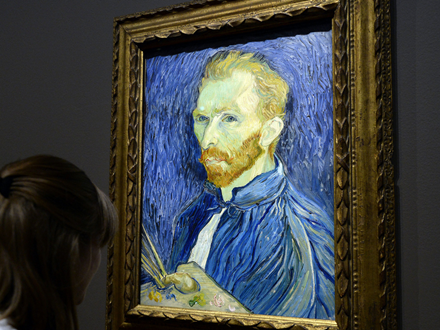
The truenature of Vincent van Gogh’s death continues to be a topic ripe formystery – after aleading forensics experthas claimed that the artist was murdered。
在一位法医学专家声称画家文特森•梵高是被谋杀之后,梵高之死的真相继续成为了谜团解密的热门话题。
The Sunflowerspainter died an agonising 29hours after taking a bullet to the abdomen in a wheat field nearParis in 1890. On his death bed he apparently revealed he had shothimself。
1890年,这位向日葵画家在陷入持续苦闷的29小时之后,于巴黎近郊的麦田里朝腹部开枪自杀。临终时分在床上,他说是他朝自己开了枪。
However, Dr.Vincent Di Maio, an expert on gunshot injuries, has said that he bebelieves the wound was “not self-inflicted”。
然而,枪伤专家文特森•迪马尤博士认为这伤口“不是自己造成的”。
According toVanity Fair, Di Maio, who was a key witness at the George Zimmermantrial, said that it was highly likely that Van Gogh “did not shoothimself”。
根据《名利场》杂志的说辞, 迪马尤——这位乔治齐默尔曼试验的关键目击者声称梵高很有可能“没有朝自己开枪”。
He made theclaim in response to a request by Steven Naifeh and Gregory WhiteSmith, whose biography of Van Gogh disputes the long-held suicidetheory。
这是他对于史蒂芬•奈芬和乔治•怀特•史密斯请求的回应。奈芬和史密斯的梵高传记对于一直以来梵高自杀理论的主张提出了争议。
In Van Gogh:The Life, a 960-page book published in 2011, the PulitzerPrize-winning authors claim that the artist had been shot, possiblyaccidentally, by a couple of boys and that he had decided toprotect them by accepting the blame。
在2011年出版的960页的《梵高的一生》中,普利策的获奖作家们表示:这位画家很有可能是被两个男孩出于意外射杀的;为了保护他们,画家选择抗下责任。
Americanacademic John Rewald had talked of hearing local rumours about sucha theory in the 1930s。
在20世纪30年代,美国学者约翰•瓦尔德曾表示听过该理论的当地传闻。
But Naifeh andSmith were attacked for publishing their theory and in 2013 Louisvan Tilborgh and Teio Meedendorp published a critical review in theBurlington Magazine, which reiterated thesuicide narrative。
但是奈芬和史密斯这套理论的出版受到了攻击,且在2013年,路易斯•范蒂尔博赫和提奥•梅登多普在《伯灵顿》杂志中发表评论,重申了自杀论调。
Followingthis, Naifeh and Smith asked Di Maio to compare the two accountsand put forth his opinion。
由此,奈芬和史密斯请求迪马尤比较两者说法并提出自己的见解。
Van Tilborghand Meedendorp wrote that the son of the attendant physician at VanGogh’s death bed, Paul Junior, said Van Gogh’s wound had a “brownand purple haloaround[it]。”
范蒂尔博赫和梅登多普写道, 保罗二世——这位梵高临终床边医师随从的儿子说过,梵高的伤口周围有一圈“棕色和紫色的晕”。
According tothe authors, this meant “the gun must have been fired at very closerange … and was caused by the bullet’s impact。”
根据作者们所言,这意味着“开枪范围肯定是近距离的……而且是子弹冲击的影响。”
But Di Maiosaid: “In fact, [the purple halo] is subcutaneous bleeding fromvessels cut by the bullet and is usually seen in individuals wholive awhile。
但是迪马尤说道:“事实上,(紫色的晕圈)是子弹中伤血管后皮下流血造成的,而且常见于中枪后还留有一口气的死者。”
“Its presenceor absence means nothing。”
“它存不存在并不能说明问题。”
Meanwhile, hesaid the brown ring is “an abrasion ringand seen around virtually all entrance wounds”。
与此同时,他说道棕色的晕圈是“擦伤晕圈,并且几乎所有伤口入口都有”。
Di Maio alsosaid that if Van Gogh did shoot himself there would have been“soot, powder tattooing and searing of the skin around theentrance”。
迪马尤也声称:如果梵高没有自己开枪射杀自己,那么伤口入口就该是“被煤烟弄脏,出现粉末的纹身样,且入口处的皮肤是灼伤的”。
He said:“These would have been grossly evident. None of this is described[in any of the forensic accounts]. This indicates the muzzle wasmore than a foot or two away (closer to two rather thanone)。”
他说:“这些本该是充分的证据。但没有一条在任何法医学条目中被描述出来。这说明了开枪点距离一英尺或者两英尺以外(更有可能是两英尺)。”
In conclusionhe said: “It is my opinion that, in all medical probability, thewound incurred by Van Gogh was not self-inflicted. In other words,he did not shoot himself。”
在结论中他说道:“我的见解是这样的,在所有医学的可能性中,梵高的伤口不是自己造成的,换而言之。他没有朝自己开枪。”
However, itmay take more than Di Maio to sway academic opinion。
然而,要去撼动学术界的观点,有了迪马尤的支持还远远不够。
A curator atthe Van Gogh Museum told Naifeh and Smith in an email. “I think itwould be like Vincent to protect the boys and take the ‘accident’as an unexpected way out of his burdened life。
梵高博物馆的馆长在一封邮件中告知奈芬和史密斯,“我觉得很有可能文特森他为了保护男孩们,把这次意外当作自己不堪重负的一生所意想不到的终结。“
“But I thinkthe biggest problem you’ll find after publishing your theory isthat the suicide is more or less printed in the brains of past andpresent generations and has become a sort of self-evident truth.Vincent’s suicide has become the grand finale of the story ofthe martyr forart, it’s his crown of thorns。”
“但是我认为你们会发现一个大问题:你们出版了自己的理论后会发现,自杀论或多或少已在过去人的脑海中根深蒂固了,并且通过代代相传成为了某种意义上不言而喻的事实。梵高的自杀已成为艺术殉道之路上伟大的终章,这是他的荆棘之冠。”
(声明:本文仅代表作者观点,不代表新浪网立场。)
閺傜増姘拃锔俱仛閿涙矮鎹㈡担鏇熸暪鐠愬綊顣╁ù瀣兊缁併劋绱伴崨妯肩搼楠炲灝鎲¢惃鍡曡礋鐠囧牓鐛ラ敍宀冾嚞閸曞じ绗傝ぐ鎿勭磼閻愮懓鍤潻娑樺弳鐠囷附鍎�